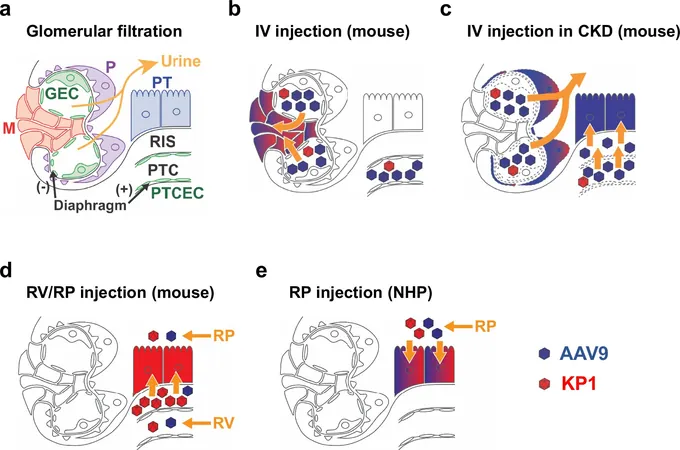
Revolutionary Gene Therapy Breakthrough Offers New Hope for Chronic Kidney Disease Patients!
2024-12-31
Author: Nur
Introduction
A new wave of innovation in gene therapy is igniting hope for individuals afflicted with chronic kidney disease (CKD). Researchers at Oregon Health & Science University are making impressive advancements with adeno-associated virus (AAV) vectors that target genetic diseases, especially in the kidneys. While AAV-based gene therapies have shown potential, delivering these crucial therapies effectively to the kidneys has long presented a significant hurdle—until now!
Breakthrough Study
The study, published in *Nature Communications*, brings promising news for patients suffering from kidney ailments. Various AAV capsids—protein shells essential for gene delivery—have been meticulously examined by researchers. These capsids are typically introduced into the body through intravenous (IV) injections. However, this traditional delivery method has significantly limited success when targeting kidney cells and often leads to unwanted side effects, particularly affecting the liver.
Innovative Delivery Methods
In an exciting turn of events, the team's extensive research unearthed valuable insights into enhancing gene delivery directly to the kidneys. Their findings reveal that different delivery methods, such as IV injections or localized injections directly into the renal vein or renal pelvis, can drastically improve targeting and minimize adverse effects. This innovative approach is a game-changer for renal gene therapy.
Key Findings and Insights
Dr. Hiroyuki Nakai, a distinguished professor in molecular medicine, and his colleagues rigorously tested 47 AAV capsids in mice, discovering one standout capid, AAV-KP1. This variant demonstrated remarkable efficiency when injected directly into the kidneys, allowing for effective absorption by kidney cells with minimal fallout on surrounding organs. Intriguingly, the well-known AAV9 capsid, which underperformed in healthy kidneys, showed unexpectedly improved targeting when administered via IV in cases of chronic kidney disease.
Complexity of Kidney Structure
Dr. Taisuke Furusho, the study’s lead author, emphasizes the complexity of the kidney's structure, which has traditionally made gene targeting a challenging endeavor. “Recent studies have shown that genetic factors contributing to kidney diseases are not just limited to children, but also prevalent in adults. If we can modify gene expression in CKD, the implications could be monumental for treatment advancements,” he stated.
Capsid Behavior and Species Differences
An essential aspect of their findings revealed notable differences in how the capsids accumulated and disseminated in the body. The researchers noted that while AAV-KP1 localized effectively at the injection site, AAV9 exhibited widespread distribution even when injected locally.
Future Implications
Moreover, the research pointed out significant variances in responses across different species. In particular, the mechanisms for virus entry in nonhuman primates proved more capable of overcoming pre-existing immunity than in mice, a revelation that could influence future therapeutic strategies.
Conclusion
Dr. Nakai emphasizes the importance of tailoring gene delivery methods to specific species and disease conditions. “This study underscores that a strategic approach, combining the right AAV capsid with optimal delivery techniques, could revolutionize treatment options for chronic kidney diseases.
With these groundbreaking advancements, the future of gene therapy for chronic kidney disease looks increasingly promising. This innovative research not only paves the way for more targeted and effective treatments but also highlights the critical importance of personalized medicine. For kidney patients looking for hope, this could be the turning point we've been waiting for!





 Brasil (PT)
Brasil (PT)
 Canada (EN)
Canada (EN)
 Chile (ES)
Chile (ES)
 Česko (CS)
Česko (CS)
 대한민국 (KO)
대한민국 (KO)
 España (ES)
España (ES)
 France (FR)
France (FR)
 Hong Kong (EN)
Hong Kong (EN)
 Italia (IT)
Italia (IT)
 日本 (JA)
日本 (JA)
 Magyarország (HU)
Magyarország (HU)
 Norge (NO)
Norge (NO)
 Polska (PL)
Polska (PL)
 Schweiz (DE)
Schweiz (DE)
 Singapore (EN)
Singapore (EN)
 Sverige (SV)
Sverige (SV)
 Suomi (FI)
Suomi (FI)
 Türkiye (TR)
Türkiye (TR)
 الإمارات العربية المتحدة (AR)
الإمارات العربية المتحدة (AR)